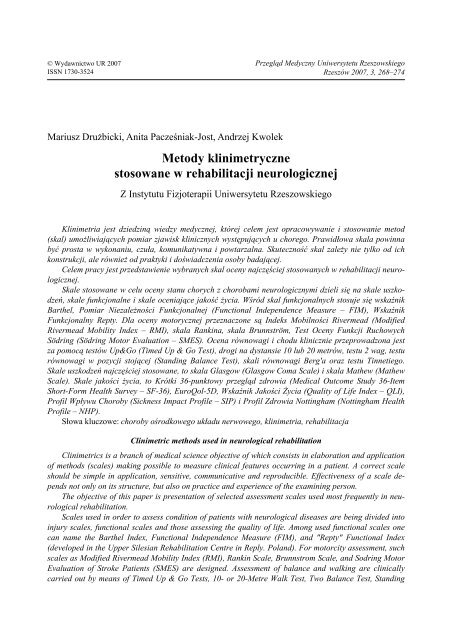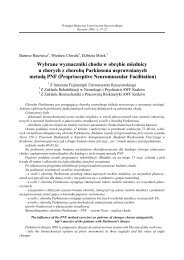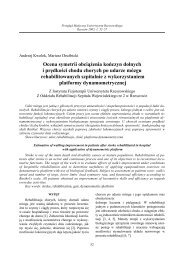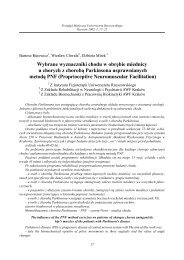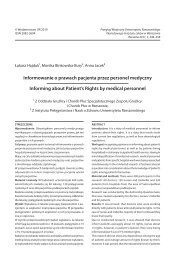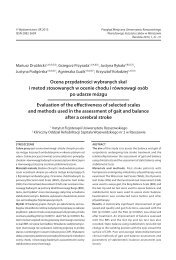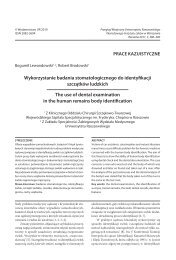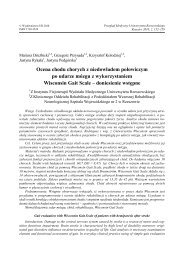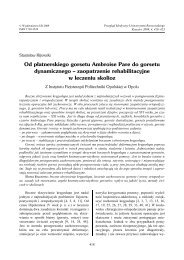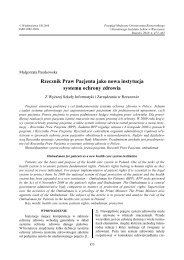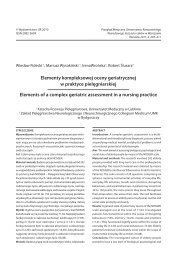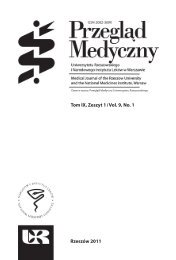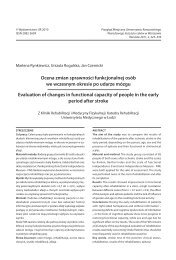Metody klinimetryczne stosowane w rehabilitacji neurologicznej
Metody klinimetryczne stosowane w rehabilitacji neurologicznej
Metody klinimetryczne stosowane w rehabilitacji neurologicznej
You also want an ePaper? Increase the reach of your titles
YUMPU automatically turns print PDFs into web optimized ePapers that Google loves.
© Wydawnictwo UR 2007<br />
ISSN 1730-3524<br />
Przegląd Medyczny Uniwersytetu Rzeszowskiego<br />
Rzeszów 2007, 3, 268–274<br />
Mariusz Drużbicki, Anita Pacześniak-Jost, Andrzej Kwolek<br />
<strong>Metody</strong> <strong>klinimetryczne</strong><br />
<strong>stosowane</strong> w <strong>rehabilitacji</strong> <strong>neurologicznej</strong><br />
Z Instytutu Fizjoterapii Uniwersytetu Rzeszowskiego<br />
Klinimetria jest dziedziną wiedzy medycznej, której celem jest opracowywanie i stosowanie metod<br />
(skal) umożliwiających pomiar zjawisk klinicznych występujących u chorego. Prawidłowa skala powinna<br />
być prosta w wykonaniu, czuła, komunikatywna i powtarzalna. Skuteczność skal zależy nie tylko od ich<br />
konstrukcji, ale również od praktyki i doświadczenia osoby badającej.<br />
Celem pracy jest przedstawienie wybranych skal oceny najczęściej stosowanych w <strong>rehabilitacji</strong> <strong>neurologicznej</strong>.<br />
Skale <strong>stosowane</strong> w celu oceny stanu chorych z chorobami neurologicznymi dzieli się na skale uszkodzeń,<br />
skale funkcjonalne i skale oceniające jakość życia. Wśród skal funkcjonalnych stosuje się wskaźnik<br />
Barthel, Pomiar Niezależności Funkcjonalnej (Functional Independence Measure – FIM), Wskaźnik<br />
Funkcjonalny Repty. Dla oceny motorycznej przeznaczone są Indeks Mobilności Rivermead (Modified<br />
Rivermead Mobility Index – RMI), skala Rankina, skala Brunnström, Test Oceny Funkcji Ruchowych<br />
Södring (Södring Motor Evaluation – SMES). Ocena równowagi i chodu klinicznie przeprowadzona jest<br />
za pomocą testów Up&Go (Timed Up & Go Test), drogi na dystansie 10 lub 20 metrów, testu 2 wag, testu<br />
równowagi w pozycji stojącej (Standing Balance Test), skali równowagi Berg'a oraz testu Tinnetiego.<br />
Skale uszkodzeń najczęściej <strong>stosowane</strong>, to skala Glasgow (Glasgow Coma Scale) i skala Mathew (Mathew<br />
Scale). Skale jakości życia, to Krótki 36-punktowy przegląd zdrowia (Medical Outcome Study 36-Item<br />
Short-Form Health Survey – SF-36), EuroQol-5D, Wskaźnik Jakości Życia (Quality of Life Index – QLI),<br />
Profil Wpływu Choroby (Sickness Impact Profile – SIP) i Profil Zdrowia Nottingham (Nottingham Health<br />
Profile – NHP).<br />
Słowa kluczowe: choroby ośrodkowego układu nerwowego, klinimetria, rehabilitacja<br />
Clinimetric methods used in neurological rehabilitation<br />
Clinimetrics is a branch of medical science objective of which consists in elaboration and application<br />
of methods (scales) making possible to measure clinical features occurring in a patient. A correct scale<br />
should be simple in application, sensitive, communicative and reproducible. Effectiveness of a scale depends<br />
not only on its structure, but also on practice and experience of the examining person.<br />
The objective of this paper is presentation of selected assessment scales used most frequently in neurological<br />
rehabilitation.<br />
Scales used in order to assess condition of patients with neurological diseases are being divided into<br />
injury scales, functional scales and those assessing the quality of life. Among used functional scales one<br />
can name the Barthel Index, Functional Independence Measure (FIM), and "Repty" Functional Index<br />
(developed in the Upper Silesian Rehabilitation Centre in Reply. Poland). For motorcity assessment, such<br />
scales as Modified Rivermead Mobility Index (RMI), Rankin Scale, Brunnstrom Scale, and Sodring Motor<br />
Evaluation of Stroke Patients (SMES) are designed. Assessment of balance and walking are clinically<br />
carried out by means of Timed Up & Go Tests, 10- or 20-Metre Walk Test, Two Balance Test, Standing
Balance Test, Berg's Balance Scale, and Tinetti test. The most frequently used scales are Glasgow Coma<br />
Scale and Mathew Scale. Quality of life scales are Medical Outcome Study 36-Item Short-Form Health<br />
Survey (SF-36), EuroQol-5D, Quality of Life Index (QLI). Sickness Impact Profile (SIP), and Nottingham<br />
Health Profile (NHP).<br />
Key words: central nervous system diseases, clinimetrics, rehabilitation


